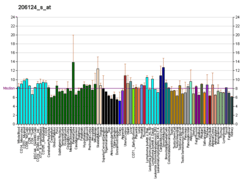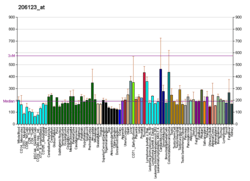LLGL1
Lethal(2) giant larvae protein homolog 1 is a protein that in humans is encoded by the LLGL1 gene.[5][6][7]
This gene encodes a protein that is similar to a tumor suppressor in Drosophila. The protein is part of a cytoskeletal network and is associated with nonmuscle myosin II heavy chain and a kinase that specifically phosphorylates this protein at serine residues. The gene is located within the Smith-Magenis syndrome region on chromosome 17.[7]
References
- ENSG00000131899 GRCh38: Ensembl release 89: ENSG00000284137, ENSG00000131899 - Ensembl, May 2017
- GRCm38: Ensembl release 89: ENSMUSG00000020536 - Ensembl, May 2017
- "Human PubMed Reference:". National Center for Biotechnology Information, U.S. National Library of Medicine.
- "Mouse PubMed Reference:". National Center for Biotechnology Information, U.S. National Library of Medicine.
- Strand D, Unger S, Corvi R, Hartenstein K, Schenkel H, Kalmes A, Merdes G, Neumann B, Krieg-Schneider F, Coy JF, et al. (Aug 1995). "A human homologue of the Drosophila tumour suppressor gene l(2)gl maps to 17p11.2-12 and codes for a cytoskeletal protein that associates with nonmuscle myosin II heavy chain". Oncogene. 11 (2): 291–301. PMID 7542763.
- Koyama K, Fukushima Y, Inazawa J, Tomotsune D, Takahashi N, Nakamura Y (Mar 1996). "The human homologue of the murine Llglh gene (LLGL) maps within the Smith-Magenis syndrome region in 17p11.2". Cytogenet Cell Genet. 72 (1): 78–82. doi:10.1159/000134167. PMID 8565641.
- "Entrez Gene: LLGL1 lethal giant larvae homolog 1 (Drosophila)".
Further reading
- Campbell HD, Fountain S, Young IG, et al. (1997). "Genomic structure, evolution, and expression of human FLII, a gelsolin and leucine-rich-repeat family member: overlap with LLGL". Genomics. 42 (1): 46–54. doi:10.1006/geno.1997.4709. PMID 9177775.
- Ludford-Menting MJ, Thomas SJ, Crimeen B, et al. (2002). "A functional interaction between CD46 and DLG4: a role for DLG4 in epithelial polarization". J. Biol. Chem. 277 (6): 4477–84. doi:10.1074/jbc.M108479200. PMID 11714708.
- Bi W, Yan J, Stankiewicz P, et al. (2002). "Genes in a Refined Smith-Magenis Syndrome Critical Deletion Interval on Chromosome 17p11.2 and the Syntenic Region of the Mouse". Genome Res. 12 (5): 713–28. doi:10.1101/gr.73702. PMC 186594. PMID 11997338.
- Strausberg RL, Feingold EA, Grouse LH, et al. (2003). "Generation and initial analysis of more than 15,000 full-length human and mouse cDNA sequences". Proc. Natl. Acad. Sci. U.S.A. 99 (26): 16899–903. doi:10.1073/pnas.242603899. PMC 139241. PMID 12477932.
- Yamanaka T, Horikoshi Y, Sugiyama Y, et al. (2004). "Mammalian Lgl forms a protein complex with PAR-6 and aPKC independently of PAR-3 to regulate epithelial cell polarity". Curr. Biol. 13 (9): 734–43. doi:10.1016/S0960-9822(03)00244-6. PMID 12725730.
- Grifoni D, Garoia F, Schimanski CC, et al. (2004). "The human protein Hugl-1 substitutes for Drosophila lethal giant larvae tumour suppressor function in vivo". Oncogene. 23 (53): 8688–94. doi:10.1038/sj.onc.1208023. PMID 15467749.
- Gerhard DS, Wagner L, Feingold EA, et al. (2004). "The Status, Quality, and Expansion of the NIH Full-Length cDNA Project: The Mammalian Gene Collection (MGC)". Genome Res. 14 (10B): 2121–7. doi:10.1101/gr.2596504. PMC 528928. PMID 15489334.
- Schimanski CC, Schmitz G, Kashyap A, et al. (2005). "Reduced expression of Hugl-1, the human homologue of Drosophila tumour suppressor gene lgl, contributes to progression of colorectal cancer". Oncogene. 24 (19): 3100–9. doi:10.1038/sj.onc.1208520. PMID 15735678.
- Kuphal S, Wallner S, Schimanski CC, et al. (2006). "Expression of Hugl-1 is strongly reduced in malignant melanoma". Oncogene. 25 (1): 103–10. doi:10.1038/sj.onc.1209008. PMID 16170365.
- Grifoni D, Garoia F, Bellosta P, et al. (2007). "aPKCzeta cortical loading is associated with Lgl cytoplasmic release and tumor growth in Drosophila and human epithelia". Oncogene. 26 (40): 5960–5. doi:10.1038/sj.onc.1210389. PMID 17369850.
This article is issued from Wikipedia. The text is licensed under Creative Commons - Attribution - Sharealike. Additional terms may apply for the media files.





